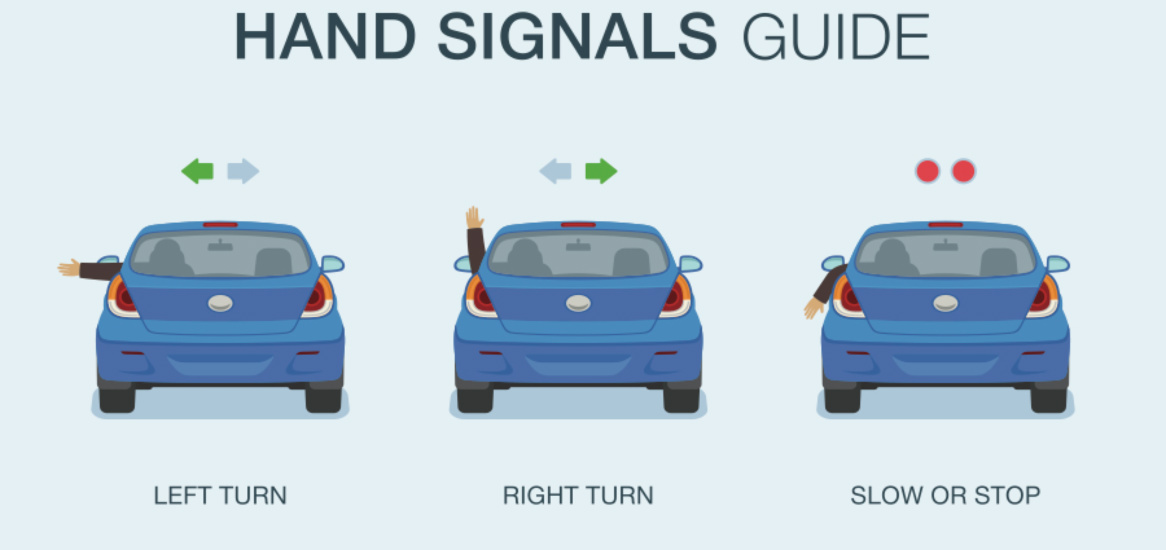

Hand signals might seem outdated in our modern world of electronic signals and sophisticated vehicle technology, but they remain a crucial skill for every driver. Whether you’re preparing for your driving test, dealing with malfunctioning turn signals, or simply want to become a more complete road user, understanding proper hand signaling can make the difference between safe communication and dangerous confusion on the road.
What are the three basic hand signals for driving? How do you signal a left turn with your hand? When should drivers use hand signals? This comprehensive guide answers these essential questions while providing step-by-step instructions for each signal. As Texas’s trusted driver education provider, Virtual Drive of Texas has helped thousands of students master these fundamental driving skills, and we’re here to ensure you have the confidence and knowledge to signal properly in any situation.
The left turn hand signal is the most straightforward of all driving hand signals. To execute this signal properly, extend your left arm straight out horizontally from the driver’s side window, keeping your arm parallel to the ground. Your palm should face forward, and your arm should be fully extended to ensure maximum visibility to other drivers and road users.
How far in advance should you give hand signals? This signal must be clearly visible and executed with adequate lead time, ideally at least 100 feet before making your turn. The left-hand turn signal is essential when your vehicle’s turn indicators malfunction, during driving tests where hand signals are required, or when operating vehicles without electronic signals, like some motorcycles or bicycles.
Are hand signals required on driving tests? Yes, state driving tests frequently include hand signal demonstrations, making this a critical skill for new drivers seeking their Texas driver’s license. Remember to maintain the signal until you complete your turn, then promptly return your hand to the steering wheel for safe vehicle control.
The right turn signal requires more coordination than the left turn signal since you’re using your left arm to indicate a rightward movement. Extend your left arm out the driver’s window, then bend your elbow to create a 90-degree angle, pointing your hand and forearm straight up toward the sky. Your palm should face forward, creating an “L” shape with your extended arm.
This arm signal should be executed clearly and maintained long enough for other drivers to recognize your intention. The right turn signal is particularly important for cyclists and motorcyclists who may have limited electronic signaling options or for any driver experiencing turn signal malfunctions on the right side of their vehicle.
Do I need to know hand signals for my driving test? Absolutely. During road tests, demonstrating proper right turn hand signals shows examiners that you understand alternative communication methods. This knowledge becomes invaluable during heavy traffic situations or when driving older vehicles with unreliable turn indicators. Understanding these signals is part of the comprehensive education you’ll receive through our Texas learner’s permit program.
What is the hand signal for stopping? The stop or slow down signal involves extending your left arm out the driver’s side window and angling it downward with your palm facing backward toward following traffic. This hand gesture clearly indicates to drivers behind you that your vehicle is decelerating or preparing to stop.
This signal proves critical when brake lights fail, during emergency braking situations, or when navigating downhill traffic where sudden speed reductions might catch following drivers off guard. The downward arm signal should be steady and visible, held firmly in position until your vehicle has come to a complete stop or slowed to a safe speed.
Parents teaching teen drivers should emphasize this signal’s importance, as it provides an additional safety layer when electronic signals fail. The stop signal also plays a vital role in driver education coursework, where students learn comprehensive vehicle communication methods.
When do you use hand signals while driving? Hand signals become necessary in several specific scenarios that every driver should understand. Equipment failures represent the most common reason for hand signaling; when turn signals, brake lights, or hazard lights malfunction, hand signals provide essential communication with other road users.
When should drivers use hand signals? Beyond equipment failures, these signals are required during driving tests and can be helpful in areas with poor visibility, such as construction zones or during inclement weather. The added visibility that deliberate hand signals provide can prevent accidents when electronic systems aren’t sufficient.
What are the standard driving hand signal timing requirements? Best practices include starting your signals at least 100 feet before taking action, checking mirrors and blind spots before signaling, and maintaining signals long enough for other drivers to process your intentions. Always ensure your signal is clearly visible and unambiguous to prevent traffic confusion.
Effective hand signaling requires deliberate, confident movements that leave no room for misinterpretation. Fully extend your arm outside the vehicle, using daylight for optimal visibility or ensuring adequate lighting when signaling at night. Hand signals should be firm and sustained, not quick or vague gestures that might confuse other drivers.
Timing plays a crucial role in hand signal effectiveness. Signal early enough to give other road users adequate warning, but avoid signaling so early that your intentions become unclear. Maintain your signal throughout the intended action, then promptly retract your arm to avoid confusion about completed maneuvers.
Weather conditions can affect hand signal visibility, so adjust your signaling intensity and duration accordingly. During rain or snow, ensure your signals are extra clear and consider using multiple communication methods when possible.
Texas state law requires drivers to use alternative signaling methods when electronic signals fail, making hand signal knowledge a legal necessity rather than merely a helpful skill. Hand signaling forms part of state driving laws, and failure to signal properly can result in traffic violations or accidents.
Driver’s education programs and learner’s permit testing include hand signal requirements, ensuring new drivers understand these fundamental communication skills. Road tests frequently assess hand signal proficiency, making proper execution essential for licensing success.
Understanding hand signal laws protects drivers from potential penalties while ensuring compliance with traffic safety regulations. Incorrect signaling or failure to signal when electronic systems fail can result in citations and increased liability in accident situations. Test your knowledge with our free DPS practice tests to ensure you’re prepared.
Different road users have unique hand signaling considerations that affect proper execution and visibility. Cyclists rely heavily on hand signals due to limited electronic signaling options, requiring extra attention to arm placement and signal duration. CDL drivers operating large commercial vehicles must ensure their signals are visible to drivers around their significantly larger vehicles.
Teen drivers benefit from comprehensive hand signal training that prepares them for both testing scenarios and real-world emergencies. Parents teaching teen drivers should emphasize hand signals as essential backup communication when technology fails.
Practice drills help reinforce correct hand signaling habits, building muscle memory that activates automatically during stressful driving situations. Regular practice ensures signals become second nature rather than awkward, uncertain gestures during critical moments.
The most frequent hand signaling errors include vague or unclear gestures that confuse rather than communicate intentions. Signaling too late provides insufficient warning to other drivers, while skipping signals entirely eliminates crucial communication during equipment failures.
Many drivers forget to retract their signals after completing actions, leaving following traffic uncertain about ongoing intentions. This mistake can cause confusion about lane changes, turns, or stops that have already been completed.
Building hand signal use into regular driving routines helps prevent these common errors. Defensive driving courses, like those offered through Texas Defensive Driving, emphasize anticipating and avoiding signaling mistakes that lead to traffic incidents.
What are the three basic hand signals for driving? The three essential signals are: left turn (arm extended straight out), right turn (arm bent upward at 90 degrees), and stop/slow down (arm angled downward with palm facing back).
How do you signal a left turn with your hand? Extend your left arm straight out horizontally from the driver’s window, keeping it parallel to the ground with your palm facing forward.
Are hand signals required on driving tests in Texas? Yes, knowledge of hand signals and demonstration is a commonly tested component of Texas driving examinations.
When should drivers use hand signals? Use hand signals when turn signals malfunction, brake lights fail, during driving tests, or in situations requiring extra visibility and communication with other drivers.
Mastering hand signals for driving represents an essential skill that connects traditional road safety with modern driving demands. These fundamental communication methods provide reliable backup when electronic systems fail and demonstrate comprehensive driving knowledge during testing situations.
Whether you’re a new driver preparing for your license, a parent teaching essential safety skills, or an experienced driver wanting to refresh your knowledge, proper hand signaling enhances your ability to communicate effectively with other road users. Understanding when and how to use these signals contributes to overall traffic flow and road safety for everyone.
Take your driving education to the next level with Virtual Drive of Texas’s comprehensive online driver’s education course. Our program covers hand signals, traffic laws, safety techniques, and everything you need to become a confident, skilled driver.
Enroll in our Texas Driver’s Education Course today and gain the complete knowledge base needed for safe, legal driving throughout Texas and beyond.
more insights
CDL Training
Defensive Driving
Driver Wellness and Health
Drivers Ed